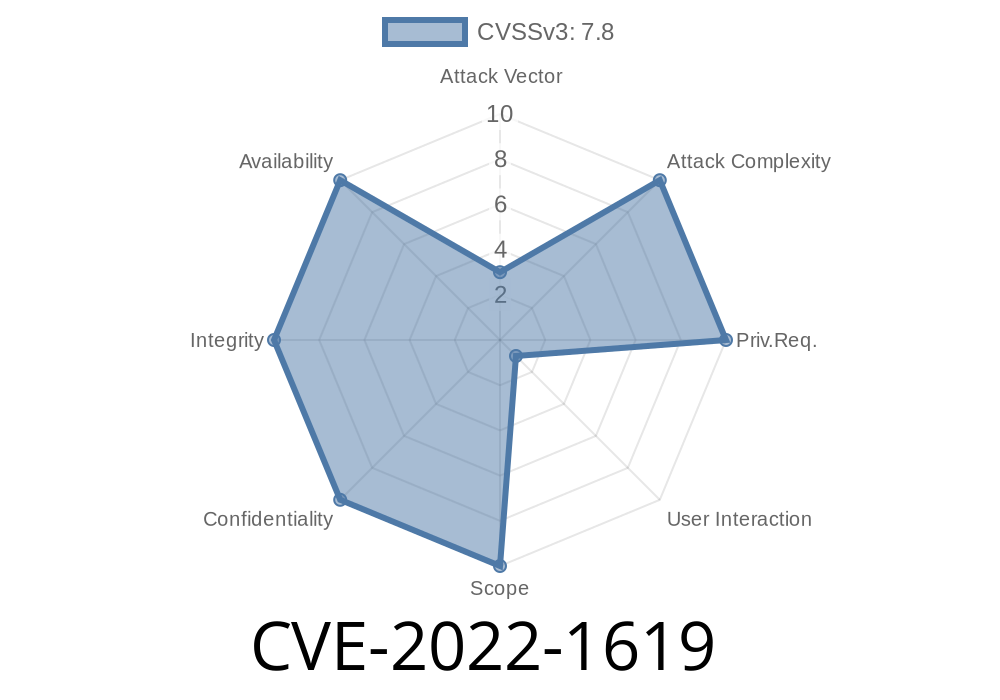In the world of text editors, few enjoy as much fame and usage as Vim. A versatile editor dating back to the early years of computing, Vim is widely appreciated for its powerful capabilities, customizable features, and rich plugin ecosystem. However, like any software, it is not without its vulnerabilities. In this post, we will explore the recently discovered CVE-2022-1619 vulnerability, explain its origins, and discuss how it can affect your system.
Background: What is CVE-2022-1619?
CVE-2022-1619 is a heap-based buffer overflow vulnerability found in the cmdline_erase_chars function of Vim up to version 8.2.4898, which is hosted on the project's GitHub repository (vim/vim). This vulnerability occurs due to improper handling of certain inputs, which may lead to memory corruption or other unintended consequences. Heap-based buffer overflows can cause software crashes, memory modification, or even remote code execution, which can compromise the security and stability of your system.
The Cause: cmdline_erase_chars Function
The cmdline_erase_chars function is responsible for erasing characters from the command line in Vim. The hea p-based buffer overflow vulnerability in this function is primarily caused when the code attempts to erase more characters than allocated in the buffer. Here's a snippet of the vulnerable code:
void cmdline_erase_chars(int *ccline, int to_erase)
{
...
multic = ccline->cmdpos / cmdcharsize;
*cmdlinep += cmdcharsize;
ccline->cmdpos -= cmdcharsize * to_erase;
*cmdlinep -= cmdcharsize * to_erase;
...
The vulnerability arises when the cmdline_erase_chars() function calculates the number of characters that need to be erased and ends up decrementing the ccline->cmdpos variable to a value less than zero. Since the length of the buffer is unsigned, this underflow condition results in a massive size value, which causes a heap-based buffer overflow.
The Exploit: A Closer Look
An attacker capable of exploiting this vulnerability can potentially crash the Vim process or execute arbitrary code on a target system. While the painstaking task of crafting a working exploit for this vulnerability is still underway, exploit developers are exploring avenues to craft a payload that bypasses security checks and leverages the overflow for remote code execution. Here's a possible exploit scenario:
An attacker prepares a malicious file designed to trigger the heap-based buffer overflow in Vim.
2. The victim unknowingly opens the file with a vulnerable version of Vim, causing the overflow to occur and corrupt the heap.
3. The attacker's payload executes on the target system, potentially granting unauthorized access or control over the system.
Mitigation and Remediation
The developers of Vim have already patched the vulnerability in version 8.2.4899, which can be found in the project's GitHub repository (https://github.com/vim/vim). To protect your system from the risks associated with CVE-2022-1619, it is highly recommended that you update your Vim installation to the latest version.
For more information on CVE-2022-1619, you can consult the following references
1. Original CVE Entry: https://cve.mitre.org/cgi-bin/cvename.cgi?name=CVE-2022-1619
2. Vim GitHub Repository: https://github.com/vim/vim
3. Vim Patch Commit: https://github.com/vim/vim/commit/335fab62c73d69ec5432499f11060cbc43dce75e
Conclusion
Vim's CVE-2022-1619 vulnerability is a reminder that even the most trusted and widely used software can harbor security issues. Heap-based buffer overflows such as this one can lead to significant software instability, data corruption, and unauthorized system access. As diligent users and administrators, it is essential to be vigilant about software updates, security awareness, and best practices to protect our systems and data from potential threats.
Timeline
Published on: 05/08/2022 10:15:00 UTC
Last modified on: 08/26/2022 20:20:00 UTC
